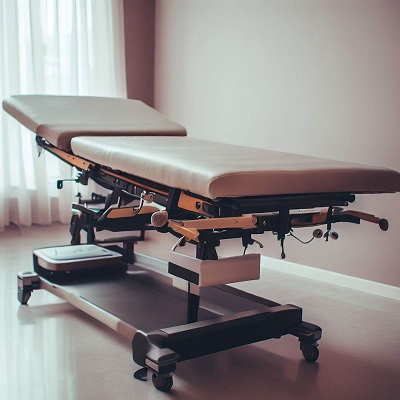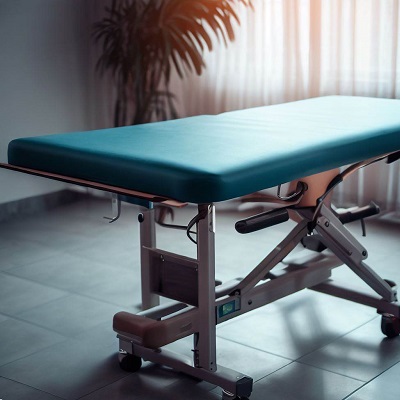Have you ever experienced discomfort or pain as a result of awkwardly positioning yourself over a treatment table during a massage or physical therapy session? Have you ever wished there was a way to make the table more comfortable and accommodating for different patients and healthcare professionals? Enter the adjustable height treatment table.
An adjustable treatment table is a specialized table with an adjustable height feature that can be adapted to promote optimal working conditions for the therapist while also providing maximum comfort and position flexibility for the patient. This type of table is commonly used in a variety of healthcare settings, such as physical therapy clinics and massage studios, but can also be useful in spas and hospitals. In this article, we'll explore the benefits and features of adjustable height treatment tables.
One of the key benefits of hi lo treatment table is the ability to accommodate different patients' heights, weights, and body types. By offering a range of customizable height options, healthcare professionals can offer patients the most comfortable and safe treatment possible.
Importantly, a hi lo treatment table can prevent musculoskeletal injuries that may result from an awkward and uncomfortable posture while performing treatments on patients. This table can be adjusted to suit the height and reach of the therapist, ensuring that they are not forced to contort their bodies to do their work.
Furthermore, using a hi lo treatment table can improve the level of care provided to patients. The therapist can adjust the table according to the type of treatment, the patient's medical history or condition, and any other factors that may impact the level of comfort provided. This adjustment can help the therapist provide more effective treatment, ensuring that the patient stays relaxed and comfortable throughout their session.
In short, using a hi lo treatment table is critical for healthcare professionals who want to create a safe and comfortable environment for their patients while also protecting themselves from work-related injuries.

1. Customizable height options for patients of different heights, weights, and body types
2. Prevents musculoskeletal injuries in healthcare professionals by enabling them to adjust the table to suit their height and reach
3. Improves the level of care provided to patients by allowing for adjustments that consider the type of treatment and the patient's medical history or condition
4. Creates a safe and comfortable environment for patients.
5. Enables healthcare professionals to work in a comfortable posture, reducing the risk of injury and strain over time.
Overall, using a hi lo treatment table is essential for healthcare professionals who want to provide high-quality care while prioritizing their own health and safety.
- Discuss how an adjustable table can make it easier for patients with mobility issues to get on and off the table
For patients with disabilities or injuries, it can be challenging to get on and off the table. An adjustable table can make it easier for patients with mobility issues to access the table safely. For example, a patient in a wheelchair can easily transfer onto the lowered table while healthcare professionals adjust the height to a suitable level. This increases accessibility for patients and helps healthcare professionals provide better quality care.
- Examine how the ability to adjust the height of the table can help make the treatment more comfortable for patients
Another benefit of an adjustable treatment table is the ability to reduce patient discomfort and pain. For example, suppose a patient needs to lie down for an extended period, such as during a massage or physical therapy session. In that case, an adjustable table can offer greater comfort and reduce the risk of developing bedsores, back pain, or muscle soreness. Healthcare professionals can adjust the height and angle to suit a patient's specific needs, providing better support and reducing discomfort.
In summary, a hi lo treatment table can improve patient comfort and accessibility, making it easier for patients with disabilities and mobility issues to access the table. Additionally, the ability to adjust the height and angle of the table can reduce patient discomfort and pain, resulting in a higher quality of care.
- Discuss how the ability to adjust the table height can help the therapist avoid awkward positions that can cause strain over time
When a therapist is working on a client for an extended period of time, it's essential for them to maintain proper posture to avoid back and neck strain. If they're in a position that causes discomfort or strain, it can affect their ability to treat the client effectively, causing suboptimal treatment outcomes. An adjustable table can make a huge difference in this regard, allowing the therapist to easily adjust the height to suit their own height and body type. By optimizing their posture, therapists can provide better and more efficient treatment services, thus helping clients achieve better results.
- Examine how an adjustable table can allow the therapist to perform the treatment more effectively, resulting in improved patient outcomes
The ability to adjust the height of the table can also improve the treatment technique of the therapist. With the ability to adjust the table to a comfortable height, the therapist can position themselves at the correct angle for each treatment technique. This can help them perform the treatment more effectively, ensuring the optimal pressure and depth is applied to the appropriate areas. With this precision, therapists can achieve better and more consistent results, leading to improved patient outcomes.
Overall, an adjustable table can greatly benefit the therapist, leading to improved ergonomics, comfort, and better treatment outcomes. By optimizing their posture and technique, therapists can help their clients achieve the best possible results.

- Discuss the importance of having a wide range of height adjustment to accommodate different patients and treatment techniques
Having a wide range of height adjustment is crucial when choosing an adjustable treatment table. This is because patients come in all shapes and sizes, and treatment techniques require different table heights. For example, a massage therapist may require a lower table height for deeper tissue work, while a physical therapist may require a higher table height for exercises involving standing or walking. Additionally, patients with mobility issues may require a higher or lower table height for ease of transfer and safety.
A range of height adjustment of at least 18 to 30 inches is ideal for accommodating different patients and treatment techniques. This ensures that the table can be adjusted to a height that is comfortable and safe for both the patient and practitioner.
- Examine the different types of adjustment mechanisms available and their pros and cons
There are different types of adjustment mechanisms available for adjustable height treatment tables. The most common ones include:
1. Electric: These tables are operated by an electric motor and can be adjusted with a push of a button. Electric tables are convenient and easy to use, especially for practitioners who require frequent height adjustments. However, they tend to be more expensive than tables with manual adjustment mechanisms.
2. Hydraulic: These tables have a hydraulic pump that is used to raise or lower the table height. Hydraulic tables are durable and easy to maintain, but manual pumping can be tiring for practitioners who require frequent height adjustments.
3. Pneumatic: These tables use air pressure to adjust the height of the table. Pneumatic tables are easy to use and require minimal effort to adjust the height. However, they tend to be less durable than tables with hydraulic or electric mechanisms.
Each type of adjustment mechanism has its pros and cons, and the choice will depend on the practitioner's needs and budget. It is important to choose a mechanism that is easy to use, durable, and provides a smooth and stable adjustment.
- Discuss the importance of choosing a table with a weight capacity that can accommodate heavier patients
As with non-adjustable tables, it is crucial to choose a hi lo treatment table that can accommodate heavier patients. adjustable height tables may have a higher weight capacity than standard stationary tables, but it's essential to verify that the table can hold the weight of the heaviest patients who will use it.
Adjustable height tables should also be stable at different heights. Moving the table up or down should not compromise its stability or structural integrity.
- Examine the materials and construction of the table to ensure that it can withstand regular use and last for years
In addition to examining the materials and construction of the table, it's essential to consider the durability of the adjustable mechanisms used to raise and lower the table.
Ensure that the mechanisms used to adjust the table height are rugged and can withstand heavy loads without breaking down quickly. The tabletop should also be thick enough to withstand bending or warping that can occur with frequent use.
Also, the electrical components used for motorized height adjustments should be of good quality and capable of handling the load without overheating or wearing out quickly. Finally, it's important to choose a hi lo treatment table that is backed by a reasonable warranty to cover any defects or failures that may occur within a reasonable time frame.

In conclusion, an hi lo treatment table offers numerous benefits for both healthcare professionals and their patients. From improved patient access and comfort to enhanced ergonomics and reduced risk of injury, an adjustable height table is a valuable and worthwhile investment.
When shopping for a hi lo treatment table, be sure to consider factors such as weight capacity, durability, stability, and warranty. Investing in a high-quality table that can withstand heavy loads and frequent use will ultimately save you time, money, and resources in the long run.
Overall, we highly recommend healthcare professionals consider adding a hi lo treatment table to their practice to provide the best care possible for their patients while improving their own work experience.